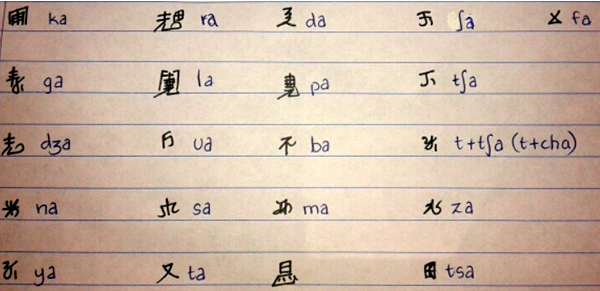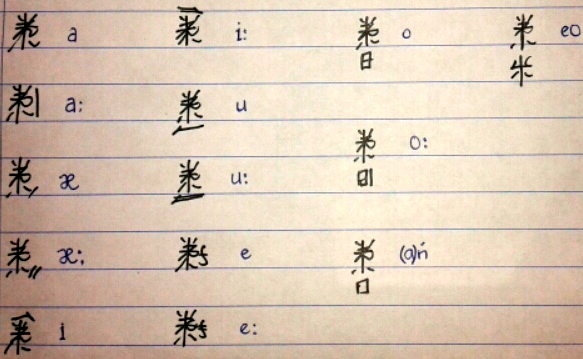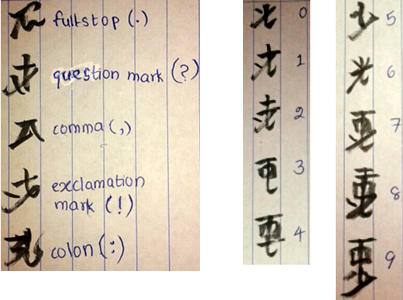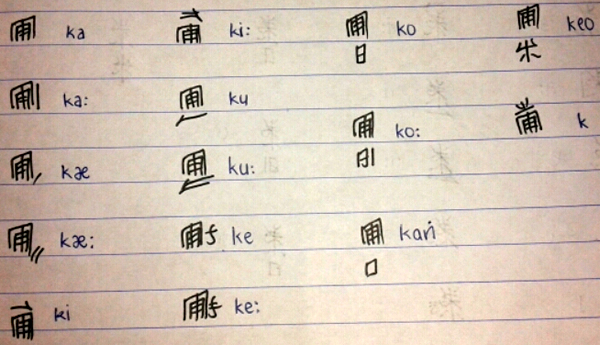Sanshuino is an abugida invented by Pulasthi Udugamasooriya during 2014, when he was just 12 years old. The script is used to write his conlang Sanshuino, which is still under construction.




Consider the word "mud". Try to pronounce the letter "d" in it, alone, in the same way it is pronounced in that word. It is quite impossible. Such letters, which cannot be pronounced on their own, are called consonants. Sanshuino has 21 consonants, two of which are digraphs. To make these consonants pronounceable, the aid of a vowel letter is required. If we add letter "a" to the letter "d" from the above example, we get "da" which can be pronounced easily. Sanshuino has 14 vowel sounds, one of which is a dipthong. (Note that although the dipthong is 'eo', it is pronounced with the 'o' sound and a very slight 'e' sound). All these 14 sounds are represented on one letter by adding certain symbols to it.
In Sanshuino too, a vowel is combined with the consonant to make it pronounceable. Here the symbols which are added to the vowels are used, instead of the whole vowel letter itself. For example, the first consonant is "ka". Writing it alone, as the first vowel, without any symbol, means it is pronounced with a short "a" sound. Adding a line to the right of the letter, as in the second vowel, means that the letter is pronounced with a long "aa" sound. If the letter should be pronounced in that particular un-pronounceable manner (just 'k', not 'ka' or 'ki' or anything), another special symbol is added to the top of the letter.

Ze nung-kepan kaodege jizeo eh lobesan be gwang-ze eh yuzweang-pan. Ko lazepaige rai mairezai eh meruzuan eh natterumyeo hatsuben fazheol juicanzhe be duisepal zomenpefai.
All human beings are born free and equal in dignity and rights. They
are endowed with reason and conscience and should act towards one another
in a spirit of brotherhood.
(Article 1 of the Universal Declaration of Human Rights)

Pulasthi Udugamasooriya
Constructed scripts for: Ainu | Arabic | Chinese languages | Dutch | English | Hawaiian | Hungarian | Japanese | Korean | Lingala | Malay & Indonesian | Persian | Tagalog / Filipino | Russian | Sanskrit | Spanish | Taino | Turkish | Vietnamese | Welsh | Other natural languages | Colour-based scripts | Tactile scripts | Phonetic/universal scripts | Constructed scripts for constructed languages | Adaptations of existing alphabets | Fictional alphabets | Magical alphabets | A-Z index | How to submit a constructed script
[top]
You can support this site by Buying Me A Coffee, and if you like what you see on this page, you can use the buttons below to share it with people you know.

If you like this site and find it useful, you can support it by making a donation via PayPal or Patreon, or by contributing in other ways. Omniglot is how I make my living.
Note: all links on this site to Amazon.com, Amazon.co.uk
and Amazon.fr
are affiliate links. This means I earn a commission if you click on any of them and buy something. So by clicking on these links you can help to support this site.
[top]